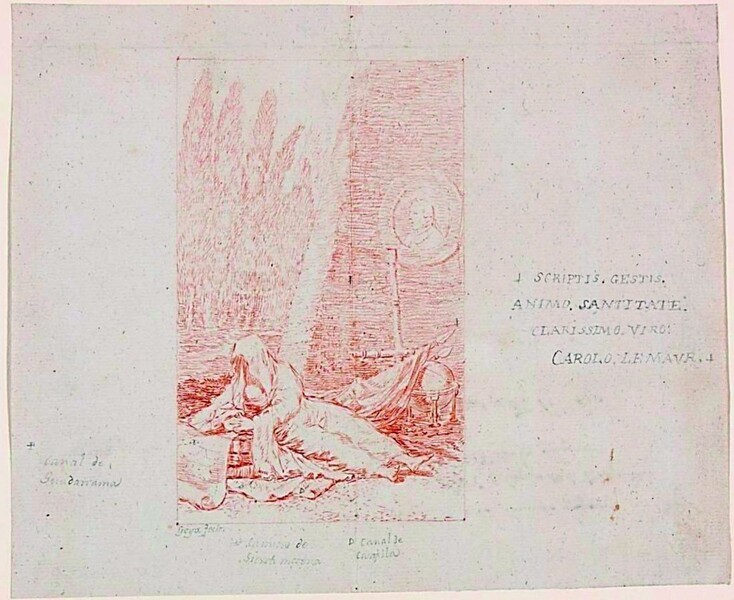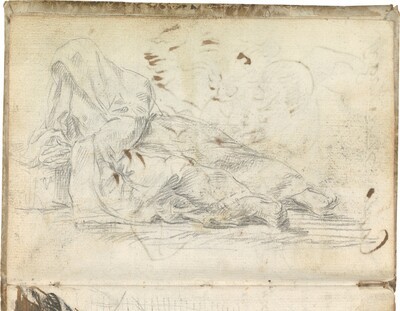- Cronología
- Ca. 1785 - 1788
- Ubicación
- Private collection, Madrid, Spain
- Dimensiones
- 213 x 258 mm
- Técnica y soporte
- Reconocimiento de la autoría de Goya
- Documented work
- Ficha: realización/revisión
- 24 Aug 2021 / 15 Jun 2023
- Inventario
- -
Goya fecit. (in pencil, lower left corner).
[sign] Canal de/Guadarrama (in pencil, left of inset).
[sign] Camino de/Sierra Morena - [sign] Canal de/Castilla (in pencil, lower left corner).
[sign] SCRIPTIS. GESTIS. / ANIMO. SANTITATE. / CLARISSIMO. VIRO. / CAROLO. LEMAVR. [sign] (in pencil, to the right of the box).
Original of the plate engraved in Paris / for the Eulogy of the Brigadier / D.n Carlos Lemaur. / By the hand of D.n Fr.co Goya (in pencil, on the back).
The drawing is from the Casa Torres Collection; it was auctioned at Durán in 1972, lot 50; Várez Fisa collection, Madrid, 1972; private collection, Madrid, 1996.
This drawing is a tribute to the memory of Charles Lemaur († Madrid, 1785), the engineer responsible for the most important projects carried out during the reign of Charles III. It was engraved in Paris in 1788 by Pierre Philippe Choffard (1730-1809).
It shows a distressed and tormented figure lying at the base of a pyramid with a background of poplars behind a stream. The figure is covered with a large amount of clothing; the head, slightly tilted, is hidden under the hood, reflecting dejection. His hands are clasped, a symbol of suffering and desolation. In front of him are unfolded drawings and several books on which he rests his arm lightly. The pyramid, two sides of which are shown, has a sketched portrait of the figure of Charles Lemaur in a tondo. At the base of the pyramid he placed a globe together with ancient measuring instruments such as the crossbow.
The background with the stream and trees refers to Lemaur's projects and work as a canal builder. Goya broke with the conventional architecture of his time and used a pyramidal representation, influenced by Rome, especially through the drawings of Piranesi, known from his trip to Italy (1769-1771). The pyramid has been understood since Roman times as a funerary symbol, an element in which Goya was interested from the beginning.
The drawing is in good condition. The sheet has two marks of having been folded, one of them horizontal, located at the top, and the other vertical in the centre.
-
Goya. Das Zeitalter der Revolucionen. Kunst um 1800 (1980 – 1981)Hamburger KunsthalleHamburg1980cat. 212a
-
Ydioma universal: Goya en la Biblioteca NacionalBiblioteca NacionalMadrid1996from September 19th to December 15th 1996cat. 71
-
Madrid2019cat. 17
-
Goya, Das Zeitalter de Revolutionen. 1789-1830HamburgPrestel-Verlag Münche und Hamburger Kunsthalle1980p. 257
-
Zaragoza1984pp. 31-38
-
Ydioma universal: Goya en la Biblioteca NacionalMadridBiblioteca Nacional, Sociedad Estatal Goya 96 y Lunwerg1996p. 113-114
-
SantanderFundación Botín y Museo Nacional del Prado2018pp. 452-456
-
MadridMuseo Nacional del Prado2019p. 74

